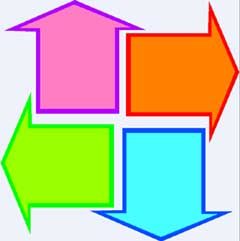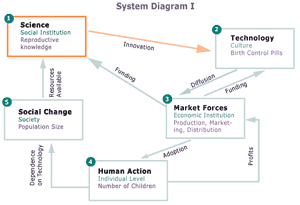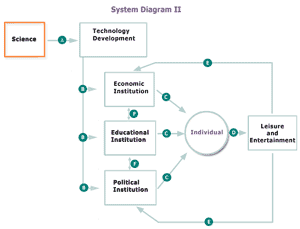|
|
 |
| Welcome | Contact | Getting Started | Site Map | Resources | 1 | 2 | 3 | 4 | 5 | 6 | 7 | 8 | 9 | 10 |
Unit 5 - Systems & Scales
Lecture |
In the previous lectures I've
talked about some elements in the sociological perspective - conceptualization,
culture, social institutions, and the sociological imagination. While
the sociological imagination helps in understanding how and why  technology
affects our lives, there is another tool for linking all of these different
elements. The concept of "system"
is used in a variety of scientific fields as a way to see how parts make
up a whole and how those parts are linked together. Computer scientists
use the concept of system. So do biologists, ecologists, economists, demographers,
and sociologists. We can use the concept of system to help understand
complex issues such as global warming and the consequences of biotechnologies.
While Volti doesn't use the word "system" in the reading for
this week, he is clearly talking about how cultural, technological, and
environmental elements are related to each other. The concept of system
can help us to organize Volti's ideas.
technology
affects our lives, there is another tool for linking all of these different
elements. The concept of "system"
is used in a variety of scientific fields as a way to see how parts make
up a whole and how those parts are linked together. Computer scientists
use the concept of system. So do biologists, ecologists, economists, demographers,
and sociologists. We can use the concept of system to help understand
complex issues such as global warming and the consequences of biotechnologies.
While Volti doesn't use the word "system" in the reading for
this week, he is clearly talking about how cultural, technological, and
environmental elements are related to each other. The concept of system
can help us to organize Volti's ideas.
As with any other concept, there are many ways to define the concept of system. One of the more common ways suggests that a system is any two or more elements related in such a way that a change in one part effects a change in all parts. Anything that affects one part of the system will have consequences for all parts of the system. The term was originally applied to biological organisms and environmental areas but has proven useful for such things as the solar system, the global economic system, and the weather. The sociological imagination is a form of systems thinking. It states that that large scale social events and individual people are linked together in such a way that anything that happens at the historical level affects the individual. It also implies that changes in large numbers of individuals will impact history. Human social systems have both material (people, buildings, computers) and non-material components (values, institutions, beliefs).
Never forget, though, that
"system" is a concept. There are no systems out there in the
world. The word "system" is merely a tool we use for describing
what we think we see.  It
is a way of organizing information, an abstraction, not something real.
We use it to divide the world up into manageable chunks so we can understand
parts of it in relation to other parts. Using the concept of system helps
us to see patterns such as culture or institutions. "System"
is a useful way of dividing up the social or natural world as long as
we don't forget that the divisions are artificial.
It
is a way of organizing information, an abstraction, not something real.
We use it to divide the world up into manageable chunks so we can understand
parts of it in relation to other parts. Using the concept of system helps
us to see patterns such as culture or institutions. "System"
is a useful way of dividing up the social or natural world as long as
we don't forget that the divisions are artificial.
Here are some characteristics of systems that will be useful as we think about the relationship between, the environment, and human health:
| Emergent Properties | When two or more parts of a system are considered together, there is usually some characteristic that emerges that is not apparent when the parts are examined individually. The whole is greater than the sum of the parts. |
| Feedback Loops | Looking at systems we can see that using a linear model (A->B->C) is too limited. Changes in C will usually be reflected in A and B. Cause and effect turn into interaction. |
| Flows of Energy and Information | The "connectors" or "arrows" in a system are as important as the parts. The parts of a system are connected by either energy flows or information flows. Energy goes from one part to another in a food chain, an electrical system, or an organism. It also connects parts of a social structure like our food production system. Information goes from one part to another in photosynthesis, plant growth or egg laying (longer days constitute information to a plant or animal). Information also flows from one part of a social organization to another as in a school or university. |
| Systems can be, and usually are, arranged in hierarchies or scales. | They have both large or macro scale and small or micro scale processes. In an ecosystem, microbes and voles are part of the micro level. Rainfall and timber harvesting are macro processes. In a human system individuals are part of the micro level while technological developments are part of the macro scale. |
The interesting thing about
hierarchies is that processes at larger scales have the potential to affect
lower scales much more rapidly  than changes at the micro scale can affect larger scales. A change in
a larger scale can affect the lower scales immediately and dramatically
while it takes a lot of cumulative changes and a long time for changes
in a smaller scale to affect larger scales. A forest fire will affect
every element in a forest ecosystem while a microbial disease takes a
long time to show effects in the forest. Technological changes in a society
change lives much faster than votes. Large scale changes in economic development,
for example, appear to affect family size more than educational campaigns
aimed at changing individual behavior. The birth rate has dropped in all
industrialized countries. This principal is part my argument about the
control of technology. The development of certain technologies, such as
automobiles or computers, cause a lot of social change very quickly. They
promote change at larger scales that affect individuals (the microlevel).
It is very difficult for people to control the social changes because
it would take a lot individuals acting together over a long period of
time to affect the macrolevels where the technologies operate. A study
of how systems work goes a long way toward explaining why we don't seem
to be able to control technological affects on culture.
than changes at the micro scale can affect larger scales. A change in
a larger scale can affect the lower scales immediately and dramatically
while it takes a lot of cumulative changes and a long time for changes
in a smaller scale to affect larger scales. A forest fire will affect
every element in a forest ecosystem while a microbial disease takes a
long time to show effects in the forest. Technological changes in a society
change lives much faster than votes. Large scale changes in economic development,
for example, appear to affect family size more than educational campaigns
aimed at changing individual behavior. The birth rate has dropped in all
industrialized countries. This principal is part my argument about the
control of technology. The development of certain technologies, such as
automobiles or computers, cause a lot of social change very quickly. They
promote change at larger scales that affect individuals (the microlevel).
It is very difficult for people to control the social changes because
it would take a lot individuals acting together over a long period of
time to affect the macrolevels where the technologies operate. A study
of how systems work goes a long way toward explaining why we don't seem
to be able to control technological affects on culture.
| Geographical | Environmental | Ecological | Social |
| Global | Global | Global | Humanity |
| Continental | Climate | Region | |
| Regional | Eco-region | Ethnic Group | |
| Land Form | Weather | Biome | Society |
| Basin | Macro-environment | Culture | |
| Drainage | Landscape | Institution | |
| Watershed | Environmental | Ecosystem | Organization |
| Sub-Watershed | Habitat | Community | Community |
| Area/Locale | Guild/Species | Extended Family | |
| Micro-environment | Individual | Individual |
Let's look at science and technology as parts of the social system with individuals at the smallest scale and society as the largest one. Science is a social institution and technology a part of culture. There are emergent properties that take place in this system. They include innovation, social change, adoption, diffusion, and dependence on technologies such as birth control pills or condoms. These emergent processes occur as a result of feedback loops and the information and energy flows between different parts of the system. They emerge as the consequence of the collective actions of many individuals but are not the result of actions by any individual actor. The actions of many individuals (or couples, I guess, this case) are what determine population size. The actions of one couple matter little. Nor are the emergent processes under the control of any individual or group. They emerge from the interactions between the different parts of the system and then operate to change the system. Technology and culture, rather than individual preference, can be seen as major factors in how many children a couple wants to have and population size in a society.
System Diagram I

Click the diagram to the right to see a larger interactive view. Note the two parts of the system diagram: boxes and arrows. The boxes represent the material components. The elements you can actually "see." The arrows represent the processes that link the material components. To make a system diagram useful for analysis, arrows are labeled, as in the diagram below, so the arrows can be discussed at length in a text component.
Here are some of the elements I might want to put into a system if I were going to look at the adoption of computers into American society. Science, as an institution, discovers (A) information that leads to the development of computers. The political, economic, and education institutions establish (B1, B2, B3) patterns of use. Individuals are (C) forced to use computers in everyday life (banks, grocery stores, schools, and in automobiles). (D) Because it is profitable, computers become a key component in leisure and entertainment. (E) In a feedback loop, computers become part of the fabric of culture and we begin to rely on them for the flow of (F) information that connects different processes in the social system. At this point they become essential to our way of life. We can no longer function without them. Here we see a development at the macro level impacting the micro levels which, in turn, causes changes affecting the overall nature of the social system. The system diagram is useful for seeing how the process works. To simplify, let's look at the leisure and entertainment.
 System Diagram II
System Diagram II
Click the diagram to the left to see a larger interactive view. The same rules from System Diagram I apply.
- A. Innovation
- Science discovers information leading to the development of computer technologies.
- B. Diffusion
- Elements in all social institutions incorporate new technologies because they allow for cost savings, better communication, and expanded areas of influence. Computers become an everyday part of economic life, educational organizations, and political activities.
- C. Adoption
- Individuals are impacted as they go about their daily lives. Students must use computers to find information or write papers. On-line services make banking easier but can also track our credit and expenditures. We canít fix our own cars anymore because that requires sophisticated equipment. The media, using instant communication technologies, provides us with enormous amounts of information about the political process. Way more than we might want to know. We might have to deal with identity theft or on-line voting.
- D. Emergent Properties
- While some people resist computers most people come to enjoy the benefits. Email becomes a routine part of our everyday lives. Cell phones move from convenience to necessity. For some groups, they become the most common form of interaction. What was a curiosity becomes essential. Our cell phones must now send pictures as well as voices. Our leisure time revolves around new technologies Ė computer games, surfing the internet, home theatre systems, digital photography. Cable or satellite TV is standard in most homes, watches can be programmed to run our lives, cars are linked to satellite communications systems that bail us out if we lock our keys inside, call for help if our airbags deploy, and give us directions to the nearest home electronics store. Our lives are different than they were even five years ago because our use of technologies is different.
- E. Social Change
- The emergence of new forms of interaction through technologies changes basic patterns of interaction. New behaviors by individuals lead to new ways for people to interact. New opportunities for businesses, educational institutions, and political organizations are created. Businesses develop new products, have new markets, and new ways to compete for market share. Educational institutions have new ways to interact with students. They can create distance education programs. They can serve students in a world-wide geographic area. Students and teachers no longer sit face-to-face and they have access to an incredible amount of information. Learning becomes more collaborative. Instant communication creates changes in the political process as people from all parts of the country or the world interact with each other. Changes in forms of interaction ARE social change. Social change consists of changes in the ways we interact with each other. Computerized technologies are changing the patterns that make up our institutions.
- F. Flow of Information Between Institutions
- Because all of our institutions are connected, changes in one result in changes in the others. To remain consistent, the patterns of activities that make up each institution are altered as we alter our behavior. Prior to computerized technologies, most interaction was face-to-face. We sat in classrooms, we bought things at stores, we voted in polling places, we went to hear political candidates or watched the state of the union address on TV. Now, we take classes over the internet, buy things on E-Bay, and click on the parts of speeches we want to hear or read the summary on Yahoo. Education becomes more market oriented, business takes another look at how education can become profitable, and plans are underway to market internet voting systems. Technology changes the way people behave and changes in behavior result in institutional change.
Understanding the role of technology in social change (or how to create or control social change) requires understanding a complex web of interactions, emergent properties, and the feedback loops created by flows of information and energy. What is cause at one level is effect at another. The concept of systems helps to sensitize us to the complexity of understanding technology in social context. For example, the role of birth control technologies in controlling world population is far from clear. Reducing the birth rate is not as simple as handing out condoms. While technology is an aid, it is not a panacea. The role of technology needs to be understood in a social and cultural context if we are to be effective agents of social change.
| |
| Welcome | Contact | Technical | Site Map | Resources | 1 | 2 | 3 | 4 | 5 | 6 | 7 | 8 | 9 | 10 |